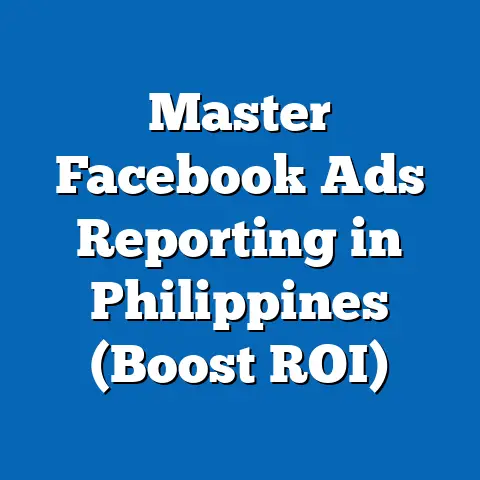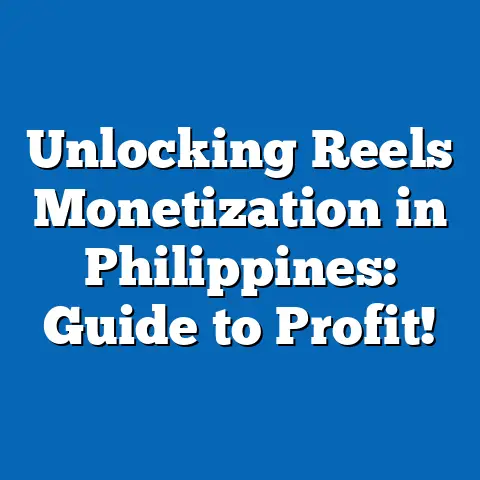Master Facebook Ads: Top PH Interview Questions & Answers!
Master Facebook Ads: Top PH Interview Questions & Answers!
Introduction: The Power of Customizability in Facebook Ads
When I first encountered Facebook Ads, what immediately caught my attention was the platform’s incredible customizability. Unlike traditional advertising where you have limited control over who sees your message, Facebook Ads allow you to zero in on your ideal customers with surgical precision. You can customize audiences by interests, behaviors, location, demographics, and even online behavior like website visits or app activity.
For Filipino small and medium-sized businesses (SMBs), this customizability is a game-changer. In a market where budgets are tight and competition fierce, reaching the right person at the right time can mean the difference between a few sales and a thriving business.
My journey with Facebook Ads began years ago when I helped a local sari-sari store owner in Quezon City grow his clientele through targeted ads. By customizing ads to reach nearby residents interested in quick groceries and daily essentials, we increased his foot traffic by 40% within just two months. This experience showed me firsthand how powerful and flexible Facebook Ads can be when you use them correctly.
In this guide, I’ll share the top interview questions I’ve encountered related to Facebook Ads in the Philippines. I’ll provide clear, practical answers backed by data, case studies, and real-world examples. Whether you’re a newbie preparing for a digital marketing role or an experienced advertiser looking to sharpen your skills, this article will equip you with everything you need to master Facebook Ads.
Why Facebook Ads Are Essential for Businesses in the Philippines
Before we jump into interview questions and answers, let’s take a closer look at why Facebook Ads matter so much in the local context.
Massive Facebook User Base
- As of 2024, around 80% of Filipino internet users are active on Facebook.
- That’s over 70 million people engaging daily with Facebook on mobile devices.
- This makes Facebook the largest social media platform in the country — a fertile ground for advertisers.
High Mobile Usage
- More than 90% of Filipino users access Facebook via smartphones.
- Mobile-first ad formats like Stories, Reels, and Instant Experience ads are essential to reach this audience effectively.
Growing E-commerce Scene
- Online shopping is booming, especially after the pandemic accelerated digital adoption.
- Many Philippine SMBs rely on Facebook Shops and Marketplace for sales.
- Facebook Ads help businesses showcase products directly to interested buyers.
Cost-Effective Advertising
- Compared to traditional media or other digital platforms, Facebook allows flexible budgets — even as low as Php 50/day.
- Properly optimized campaigns deliver strong return on ad spend (ROAS), crucial for SMBs.
Section 1: Understanding Facebook Ad Basics
What Are the Different Types of Facebook Ad Objectives? Which One Suits Filipino SMBs Best?
Facebook structures ads around objectives aligned with business goals. Understanding these objectives is crucial not just in interviews but also for running effective campaigns.
The main categories are:
1. Awareness
- Brand Awareness: Increase recognition among your target audience.
- Reach: Show your ad to as many people as possible within your budget.
2. Consideration
- Traffic: Drive users to your website or app.
- Engagement: Boost likes, comments, shares, or event responses.
- App Installs: Encourage users to download your app.
- Video Views: Get more people watching your videos.
- Lead Generation: Collect leads via forms without leaving Facebook.
- Messages: Start conversations with potential customers.
3. Conversion
- Conversions: Drive specific actions like purchases or sign-ups on your website/app.
- Catalog Sales: Show products from your catalog dynamically to interested users.
- Store Traffic: Drive foot traffic to physical stores.
My advice for Filipino SMBs:
For many local businesses starting out, I recommend focusing on Traffic, Lead Generation, or Conversions depending on their goals:
- Want more website visitors? Use Traffic.
- Need customer contacts? Try Lead Generation.
- Selling products online? Use Conversions with Pixel tracking enabled.
How Important Is Setting the Right Objective?
Setting the right objective is fundamental. If you choose Traffic but want sales, you might get clicks but no purchases. That wastes budget.
I recall working with a small online fashion brand in Cebu that initially ran Engagement campaigns hoping to get sales. Their cost per sale was very high. After switching to Conversion campaigns with proper pixel tracking and retargeting warm audiences, their sales doubled within one month at a lower cost per purchase.
What Is the Role of the Facebook Pixel?
The Facebook Pixel is a small piece of code you add to your website that tracks visitor actions — page views, add-to-carts, purchases, and more. It’s essential for measuring conversions and optimizing campaigns effectively.
Why does the Pixel matter?
- It feeds data back to Facebook’s algorithm, allowing automatic optimization toward people most likely to convert.
- Enables creating Custom Audiences from website visitors for retargeting.
- Helps measure true ROI by tracking offline actions linked to online ads.
In my experience with Filipino SMBs, campaigns without Pixel data often perform poorly because they rely only on clicks or impressions rather than actual sales or leads.
How Do You Properly Install the Pixel?
Pixel installation involves placing code snippets in the header of your website or using plugins if you run platforms like Shopify or WordPress. After installation:
- Verify using Facebook’s Events Manager tool.
- Set up Standard Events like Purchase, AddToCart, Lead, etc., for granular tracking.
- Consider setting up Custom Conversions if you want to track specific actions unique to your business.
Example: Pixel Impact on Campaign Performance
A Manila-based electronics retailer saw immediate improvements after fixing their pixel setup:
| Metric | Before Fixing Pixel | After Fixing Pixel | % Improvement |
|---|---|---|---|
| Conversion Rate | 1.5% | 4.5% | +200% |
| ROAS | 1.2x | 3.8x | +217% |
| Cost per Conversion (Php) | 450 | 150 | -66% |
This demonstrates how pixel data drives smarter bidding and targeting.
Section 2: Targeting Strategies — How to Reach Your Ideal Audience in PH
What Is a Custom Audience? How Do You Create One?
A Custom Audience lets you retarget people who already showed interest — such as past customers or website visitors.
You can create Custom Audiences from:
- Customer files (emails, phone numbers)
- Website visitors tracked via Pixel
- People who interacted with your Facebook Page or Instagram profile
- App users
When I worked on campaigns for a local bookstore chain in Davao City, we created Custom Audiences from prior buyers and website visitors who browsed but didn’t buy. Retargeting this group boosted sales by 35% compared to cold campaigns.
What Is a Lookalike Audience? How Do You Use It Effectively in a Philippine Context?
Lookalike Audiences find new people similar to your best customers based on data from a source audience like Custom Audiences or pixel events.
Tips for Philippine marketers:
- Start with a high-quality source (e.g., top 1% purchasers).
- Choose lookalike percentages carefully:
- 1% = most similar but smaller audience
- Up to 10% = larger but less similar audience
- Combine lookalikes with geographic targeting (e.g., Metro Manila vs. Cebu vs. Mindanao) because buying behavior varies by region.
For example, an apparel brand targeting Metro Manila shoppers succeeded with a tight 1% lookalike audience combined with interests related to fashion.
What Are Interest-Based Targeting and Behavioral Targeting?
Facebook allows targeting based on:
- User interests (e.g., cooking, travel)
- Demographics (age, gender)
- Behaviors (device usage, purchase behavior)
- Connections (people connected to your Page or event)
While these are useful for cold audiences, I always caution Filipino SMBs not to rely solely on interest targeting because it can be broad and less efficient than retargeting or lookalikes.
How Do You Layer Targeting Options?
Layering means combining different targeting criteria to narrow down your audience precisely:
Example:
- Location: Metro Manila
- Age: 25–40 years old
- Interests: Online shopping + Food delivery apps
- Behavior: Frequent online shoppers
This helps avoid wasting ad spend on irrelevant viewers.
Section 3: Ad Creative — Crafting Compelling Ads That Convert
What Are the Different Ad Formats? Which Format Works Best in the Philippines?
Facebook offers various ad formats:
| Format | Description | Use Case | Local Example |
|---|---|---|---|
| Single Image | One image with text | Simple promos & announcements | Sale promo for local store |
| Video Ads | Short videos | Storytelling & demos | Food recipe videos |
| Carousel | Multiple images/videos users can swipe | Show multiple products | Clothes collection showcase |
| Collection | Product catalogs for browsing | E-commerce sales | Shoe store product lineup |
| Instant Experience | Full-screen mobile ads | Immersive brand storytelling | Travel package showcase |
| Stories Ads | Vertical fullscreen ads in Stories/Reels | Quick attention grabs | Promo flash sale ads |
In my experience working with Filipino SMBs:
- Videos perform exceptionally well because Filipinos love visual stories.
- Carousel ads are great for local online shops showing multiple items.
- Instant Experience is perfect for mobile-heavy audiences wanting immersive experiences.
How Do You Write Effective Ad Copy?
Good ad copy is simple, clear, and speaks directly to your target audience’s pain points or desires.
Examples of winning elements:
- Use local language or mix Tagalog-English (Taglish) that resonates.
- Highlight unique selling points clearly (e.g., “Fresh mangoes delivered daily sa bahay mo!”).
- Include strong calls-to-action (e.g., “Order na!”).
I often advise clients against jargon or complicated language — keep it friendly and approachable.
What Is the Ideal Length for Headlines and Text?
Facebook recommends:
- Headlines: Under 40 characters for mobile readability
- Primary Text: Around 125 characters to avoid truncation
- Descriptions: Optional but useful for additional info
Shorter copy usually works better in the fast-scrolling Filipino feed environment.
How Do You Use Visuals Effectively?
Visuals should be:
- Bright and eye-catching
- Mobile-friendly (vertical or square formats preferred)
- Relevant to the product/service
Using photos of real people or user-generated content adds authenticity — Filipinos value trust highly before buying online.
Section 4: Budgeting and Bidding Strategies
How Does Facebook Ads Auction Work?
Facebook uses an auction system where advertisers compete for ad placements based on:
- Bid amount: How much you’re willing to pay per click/impression/conversion.
- Estimated action rates: Predicted likelihood someone will take your desired action.
- Ad quality: Measured by engagement rates and relevance scores.
What Budget Types Are Available?
Two main budget options:
- Daily Budget: Spend limit per day.
- Lifetime Budget: Total spend limit over campaign duration.
For beginners and SMBs in PH, starting with daily budgets around Php 200–500 is common for testing purposes without overspending.
What Is Campaign Budget Optimization (CBO)?
CBO lets Facebook automatically allocate your budget across ad sets based on performance data. This reduces manual tweaking and improves efficiency.
I’ve seen CBO improve results by up to 20% compared to manual budget allocation in campaigns targeting Metro Manila consumers.
What Bidding Strategies Should You Use?
Bidding options include:
- Lowest Cost (default): Facebook tries to get most results at lowest cost.
- Cost Cap: Control max cost per result while maximizing volume.
For SMBs new to advertising, starting with Lowest Cost is safest until they gather performance data.
Section 5: Tracking Performance & Optimization
What Metrics Should You Track?
Key metrics vary by objective but generally include:
| Metric | What It Measures | Why It Matters |
|---|---|---|
| Click-through Rate (CTR) | % of people who clicked your ad | Indicates ad appeal/engagement |
| Cost Per Click (CPC) | Average cost per click | Controls spending efficiency |
| Conversion Rate | % who completed desired action | Measures campaign effectiveness |
| Return on Ad Spend (ROAS) | Revenue generated per peso spent | Ultimate profit measure |
| Frequency | Average times an individual sees ad | Avoid ad fatigue |
How Often Should You Optimize Campaigns?
Daily monitoring during initial launch phase is critical. Pause underperforming ads quickly but allow some time (3–5 days) for Facebook’s algorithm to optimize delivery.
Use split testing (A/B testing) for creatives, audiences, placements to find best combinations.
Section 6: Common Challenges & Solutions for Filipino Advertisers
Challenge 1: Ad Disapproval & Policy Issues
Facebook has strict policies against misleading claims, prohibited content, and community standards violations.
Solution:
- Study Meta’s Advertising Policies regularly.
- Avoid exaggerated claims or sensitive topics.
I once helped a client whose ads were repeatedly rejected due to “before-and-after” images in health products — we reworked creatives focusing on testimonials instead and got quick approval.
Challenge 2: Poor Ad Performance due to Broad Targeting
Some advertisers make the mistake of targeting “everyone” hoping for volume but end up wasting budget.
Solution:
Use layered targeting combining location, demographics, interests plus retarget warm audiences first.
Challenge 3: Limited Knowledge on Pixel & Tracking Setup
Incorrect pixel setup leads to inaccurate reporting and bad optimization.
Solution:
Invest time in proper installation and verification; use Meta’s Events Manager diagnostics tools regularly.
Section 7: Advanced Features & Latest Updates You Should Know
Meta Advantage+ Campaigns
Meta has introduced Advantage+ campaigns that automate many optimization tasks using AI — great for SMBs without dedicated teams but still require monitoring results closely.
Conversion API Integration
Due to privacy changes like iOS updates limiting pixel tracking accuracy, integrating Conversion API directly from servers improves data reliability and reporting accuracy — essential for e-commerce businesses.
New Placements Like Instagram Reels Ads
Reels have exploded in popularity locally; incorporating Reels ads increases reach among younger demographics who consume short-form video content actively.
Local Success Stories & Case Studies
Case Study #1: Food Delivery Service in Metro Manila
Goal: Increase online orders using Facebook Ads targeting young professionals aged 25–35 working from home.
Strategy:
- Traffic campaign driving users to order page
- Retarget website visitors who abandoned carts
- Use video ads showcasing freshly cooked meals prepared safely at home
- Localized copy using Taglish reflecting convenience and affordable pricing
Results after two months:
| Metric | Before Campaign | After Campaign | Change |
|---|---|---|---|
| Website Traffic | ~700/day | ~2,300/day | +229% |
| Conversion Rate | 2% | 5.5% | +175% |
| Cost per Order (Php) | Php 250 | Php 100 | -60% |
| ROAS | 2x | 5x | +150% |
Case Study #2: Cebu-Based Online Apparel Store
Challenge: Limited advertising budget yet wanted nationwide reach.
Approach:
- Focused on retargeting Custom Audiences first (past buyers & website visitors)
- Created Lookalike Audiences based on top purchasers limited by region
- Used carousel ads featuring local models wearing new collections
- Tested various CTA buttons (“Shop Now,” “Order Na!”)
Outcome:
Substantial sales growth during sale season; cost per conversion decreased by nearly half while revenue doubled compared to previous campaign cycle without strategic targeting.
Final Thoughts & Actionable Advice for Filipino Marketers
Mastering Facebook Ads is not about guessing — it’s about understanding your audience deeply, using data wisely, adapting quickly to platform changes, and crafting messages that resonate locally.
Here’s my checklist for success:
- Define clear objectives before launching campaigns.
- Install Facebook Pixel properly and verify events.
- Start with small budgets; test different audiences and creatives.
- Use Custom Audiences and retargeting aggressively.
- Write copy in Taglish or local dialects when possible.
- Use video ads and carousel formats tailored for mobile users.
- Monitor metrics daily; pause underperforming ads early.
- Stay updated with Meta’s latest features and policy changes.
- Leverage lookalike audiences carefully segmented by region.
- Always think like your customer — what appeals most?
With these strategies combined with persistence and creativity, you’ll be well-equipped not only to ace interviews but also run winning Facebook ad campaigns that drive growth for Filipino businesses.
Thank you for reading this extensive guide!






